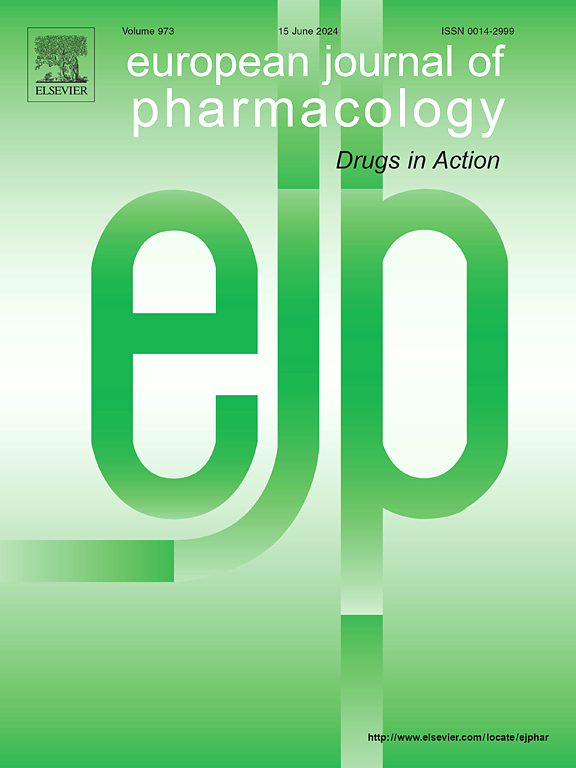孟德尔随机化分析与GEO数据库:探索胰岛素治疗围手术期神经认知障碍的分子机制
IF 4.2
3区 医学
Q1 PHARMACOLOGY & PHARMACY
引用次数: 0
摘要
中枢性胰岛素抵抗是围手术期神经认知障碍(PND)的重要因素,但胰岛素的治疗效果和潜在的分子机制尚不清楚。我们进行了一项双向孟德尔随机化(MR)研究,以调查胰岛素使用与PND之间的因果关系。前向磁共振分析显示,使用胰岛素可显著降低谵妄的风险(优势比[OR] = 0.01, 95%可信区间[CI]: 0.0007-0.22, P = 0.003),增强认知能力(OR = 8.03, 95% CI: 2.83-22.78, P = 0.001)。重要的是,反向MR分析表明,认知障碍或谵妄对胰岛素使用没有因果关系(or≈1.0,P >;0.5)。利用GEO数据集,我们确定了63个差异表达基因(DEGs),这些基因在术后谵妄和胰岛素治疗中都是常见的。随后的分析,包括蛋白-蛋白相互作用网络的构建、基因本体(GO)和KEGG通路分析,确定了EPN2、DNAJC6、ARFGAP1和HIP1R是可能作为PND潜在治疗靶点的关键枢纽基因。进一步的研究表明,这些枢纽基因是一个多途径相互作用网络的一部分,可能在PND的发生和发展中起着重要作用,胰岛素也影响着它们的调节。我们的研究结果建立了胰岛素在PND治疗作用的单向遗传因果关系,揭示了新的分子靶点,从而提高了我们对胰岛素治疗PND机制的理解。本文章由计算机程序翻译,如有差异,请以英文原文为准。
Mendelian randomization analysis with the GEO database: Exploring the molecular mechanism underlying insulin therapy for perioperative neurocognitive disorders
Central insulin resistance is a significant factor in perioperative neurocognitive disorders (PND), yet the therapeutic effects and underlying molecular mechanisms of insulin remain unclear. We conducted a bidirectional Mendelian randomization (MR) study to investigate the causal relationships between insulin use and PND. The forward MR analysis revealed that insulin use considerably reduced the risk of delirium (odds ratio [OR] = 0.01, 95 % confidence interval [CI]: 0.0007–0.22, P = 0.003) and enhanced cognitive performance (OR = 8.03, 95 % CI: 2.83–22.78, P = 0.001). Importantly, the reverse MR analysis indicated that cognitive impairment or delirium did not causally affect insulin use (OR ≈ 1.0, P > 0.5). Utilizing GEO datasets, we identified 63 differentially expressed genes (DEGs) common to both postoperative delirium and insulin treatment. Subsequent analyses, including the construction of a protein-protein interaction network and Gene Ontology (GO) and KEGG pathway analyses, identified EPN2, DNAJC6, ARFGAP1, and HIP1R as key hub genes that could serve as potential therapeutic targets for PND. Further research showed that these hub genes are part of a multi-pathway interactive network, which may significantly contribute to the onset and progression of PND, with insulin also affecting their regulation. Our results establish a unidirectional genetic causality for the therapeutic effects of insulin in PND and reveal new molecular targets, thereby improving our understanding of the mechanisms behind insulin treatment for PND.
求助全文
通过发布文献求助,成功后即可免费获取论文全文。
去求助
来源期刊
CiteScore
9.00
自引率
0.00%
发文量
572
审稿时长
34 days
期刊介绍:
The European Journal of Pharmacology publishes research papers covering all aspects of experimental pharmacology with focus on the mechanism of action of structurally identified compounds affecting biological systems.
The scope includes:
Behavioural pharmacology
Neuropharmacology and analgesia
Cardiovascular pharmacology
Pulmonary, gastrointestinal and urogenital pharmacology
Endocrine pharmacology
Immunopharmacology and inflammation
Molecular and cellular pharmacology
Regenerative pharmacology
Biologicals and biotherapeutics
Translational pharmacology
Nutriceutical pharmacology.

 求助内容:
求助内容: 应助结果提醒方式:
应助结果提醒方式:


